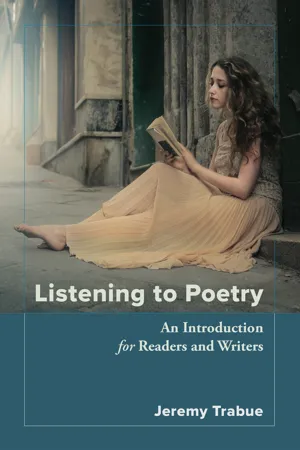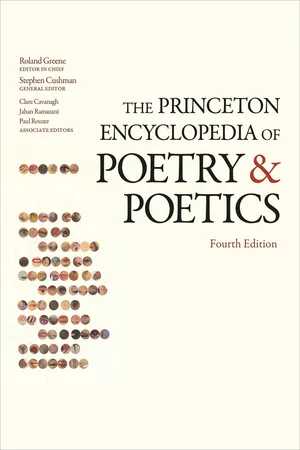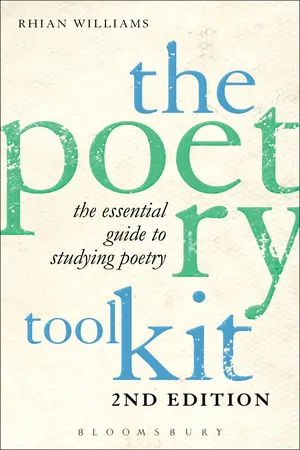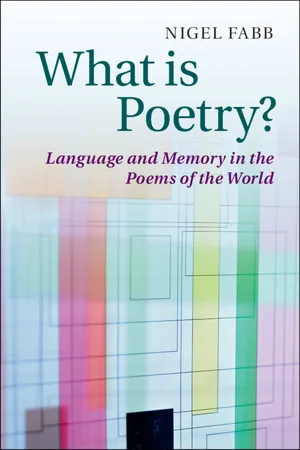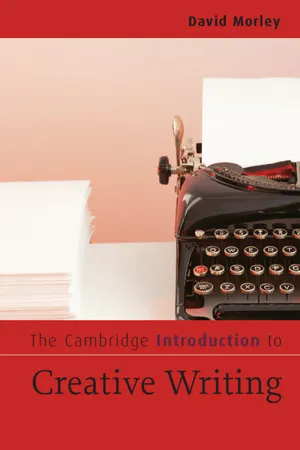Languages & Linguistics
End Rhyme
End rhyme refers to the rhyming of the final words of lines in a poem or song. It is a common poetic device used to create rhythm and musicality in the text. End rhyme is often denoted by letters to indicate the pattern, such as AABB or ABAB.
Written by Perlego with AI-assistance
Related key terms
1 of 5
5 Key excerpts on "End Rhyme"
- Available until 18 Jan |Learn more
Listening to Poetry
An Introduction for Readers and Writers
- Jeremy Trabue(Author)
- 2019(Publication Date)
- Chemeketa Press(Publisher)
At the other extreme, there are also many people who think of nonrhyming poetry as “modern” and rhyming poetry as “traditional.” This is also inaccurate. Old English poetry did not rhyme at all, nor did much poetry in Middle English. Unrhymed verse has been part of modern English right from the beginning. Seventeenth-century poet John Milton wrote a blistering attack on rhyme in his introduction to Paradise Lost (which does not rhyme). And most early English dramatic verse is mostly written without any rhyme (though some short rhyming passages do appear in Shakespeare and other renaissance drama).The role and importance of rhyme in poetry was much debated and contested in Milton’s time, and it still is today. Unrhymed poetry is more common, but rhyming poetry is alive and well. Rhyme is not omnipotent or omnipresent. Rhyme does not define “poem.” However, it is a part of poetry, and it’s here to stay.Rhyme is one of those subjects for which the phrase “deceptively simple” was created. Most preschoolers recognize and can give examples of rhyming words. Most could easily recognize the rhymes in this list:bed / embed / said / read bay / weigh / astray / they wing / asking / unifying / testifying lady / bee / abbey / tabbyBut what exactly makes these words “rhyming”? The entire ending syllable is not exactly the same in each one because the ending syllables may start with different consonant sounds. The spelling is certainly not the same in each one. However, the ending syllable after its initial con sonant sound is the same. Notice that they don’t have to have the same number of syllables, either, as long as that final syllable sound after its initial consonant is identical.Rhyme is the repetition of the same vowel sound followed by the same consonant sound—if there is one—in the final syllable of two or more words and in close enough proximity that it creates an obvious pattern. That’s the basic definition, but there is a lot of variation just under the surface of that definition that you should be aware of.Varieties of Rhyme
Rhyme is such a rich subject that there are different varieties of rhyme.First, rhymes can be either internal or end. End Rhyme occurs at the ends of lines, and is the most common.When people talk about rhyme, they usually mean End Rhyme. Internal rhyme, - eBook - ePub
The Princeton Encyclopedia of Poetry and Poetics
Fourth Edition
- Stephen Cushman, Clare Cavanagh, Jahan Ramazani, Paul Rouzer, Stephen Cushman, Clare Cavanagh, Jahan Ramazani, Paul Rouzer(Authors)
- 2012(Publication Date)
- Princeton University Press(Publisher)
But again, it is essential to bear in mind that, even for rhyme types directly appropriated from the Romance langs. and for which the Eng. terms are simply direct trans., the effect is not the same: rhyme is a markedly different phenomenon in inflectional langs., where identity of word ending is pervasive and often must be actually avoided, than in positional langs., where inflectional endings are almost entirely absent and where sound similarity is more dependent on the historical evolution of the lexicon. Notwithstanding, this difference does not automatically make the Romance langs. rhyme “rich” and the Germanic langs. rhyme “poor,” as has often been thought: it is not merely the quantity of like endings that is at issue.D. Analogues .Inside poetry, there are a number of structures that have rhyme-like effects or functions or exceed the domain of rhyme, verging into repetition. The *sestina, e.g., repeats a sequence of whole words rather than rhyme sounds. Several rhetorical devices generate comparable effects to those of rhyme even in unrhymed verse: in the 10,000 lines of Paradise Lost , there are over 100 cases of epistrophe, nearly 100 of *anaphora, 60 of *anadiplosis, 50 of *epanalepsis, and 40 of epizeuxis, all of them, as Broadbent says, “iterative schemes tending to the effect of rhyme.” Milton also weights words at line end (Broadbent calls this “anti-rhyme”), counterposing semantically heavy and contrastive terms at Paradise Lost 4.561–62, e.g.: “Tempt not the Lord thy God, he said and stood. / But Satan smitten with amazement fell”—an effect reinforced all the more by reiteration of these two terms via *ploce ten more times in the following 21 lines, and echoed thereafter at 4.590–91 (cf. 9.832–33). In *American Sign Language poetry, poets achieve rhyme-like effects using hand shapes.Outside poetry, rhyme is commonly thought of as a “poetical” device, but, in fact, it is a broadly attested ling. structure used for marking the ends of important words and phrases to make them memorable. Rhyme is widely used not only for ludic and didactic purposes, as in rhymed and rhythmical calendrical mnemonics, children’s counting-out and jump-rope rhymes, and jingles for ads (see Chasar) but for other types of memorable speech such as *proverbs, *epigrams, inscriptions, mottoes, *riddles, puns, and jokes (Brogan). Children seem to be able to manufacture rhymes not only spontaneously and happily but more readily than the other six forms cited at the top of section II.B above, suggesting that the closural or “final-fixed” structure that is rhyme is somehow more salient for cognitive processing (see Rayman and Zaidel), as the vast lit. on the role of rhyme in promoting children’s phonemic awareness, lang. acquisition, and literacy suggests. Perhaps the most common form of rhyming in lang. is seen in mnemonic formulas, catch phrases that rhyme, e.g., true blue , ill will , fender bender , double trouble , high and dry . The list of such popular and proverbial phrases is astonishingly long, and the device is also used in poetry (Donne, “Song (Go and Catch a Falling Star”); Eliot, Four Quartets ; see CLOSE RHYME - eBook - PDF
- Rhian Williams(Author)
- 2013(Publication Date)
- Bloomsbury Academic(Publisher)
In such a view, to abandon or even just to loosen rhyme is to be revolutionary – as seen in many post-1918 poetic innovations, or Romantic experiments with ‘everyday speech’ in poetry. A poet may feel that there is no place for rhyme in a world that has lost all sense of harmonious relationship. On the other hand, excessive rhyme can also be revolutionary. Algernon Charles Swinburne, for example, used complex patterns of four, five, six, seven, eight or ten lines of interlocking rhymes in a spirit of experimentation and daring: technical brilliance and sophisticated rhyming patterns denoted scandal and subversion as he allied this rhyming excess with sexual, moral and religious excesses. The principle behind rhyme is repetition and near-collision: rhymes are the repetition (or the almost-repetition) of a sound that you have just heard. This principle of return or meeting can be used as a healing, soothing or celebratory gesture, as when Elizabeth Jennings rhymes ‘caress’ with ‘gentleness’ when she tries to characterize the emotion she feels for a friend. Despite the sense content, the matching sounds suggest a relation between the two words – both tactile and reserved – that is comforting, as though that pairing was somehow meant to be: Such love I cannot analyse; It does not rest in lips or eyes, Neither in kisses nor caress. Partly, I know, it’s gentleness Elizabeth Jennings, ‘Friendship’ (1972), ll. 1–4. However, the same principle can produce unsettling and disturbing effects. For example, in Thomas Hardy’s often-uncomfortable elegies ( Poems of 1912–13 ) for his wife, the repeated sound of rhyming creates a sense of entrapment (see the enclosing gestures at the end of each stanza in ‘Lament’, for example). - eBook - PDF
What is Poetry?
Language and Memory in the Poems of the World
- Nigel Fabb(Author)
- 2015(Publication Date)
- Cambridge University Press(Publisher)
I have not found research that shows whether the sections ending in rhymes are sufficiently short that they can each be held as a whole unit in working memory. Similarity and near similarity in rhyme and alliteration A rhyme or alliteration involves a set of words that are alike in their sound structure. This is sometimes unproblematic: for example, when the shared sounds are the phonetic forms of the words, as is true for most rhyme and alliteration in English poetry. However, in particular poetic traditions or for particular poets or poems, words can rhyme or alliterate if they share sounds that are alike but not identical. This has been extensively studied by linguists (summarised in Worth 1977; Miller 1977; Fabb 1997; Kawahara 2007). We saw examples of this above, in Irish poetry. Some have argued that the similarity depends on psycho-acoustic factors. Steriade (2003) argues this for Romanian poets and judgements of the acceptability of half-rhymes. Kern (2012) argues that in Irish, rhymes between unlike segmental structures involve changes in sonority contours. Kawahara (2007) suggests that in a Japanese rap song, the formation of rhyming sets is not categorial but gradient, based on general principles of acoustic similarity not underlying form. These are ways in which poetic form appears to be sensitive to microvariation in language. A further possibility is that two words rhyme or alliterate not because they share whole sounds at any level of phonological structure, but because they share parts of sounds. Thus, Lorimer (1954: 551) notes that in Bakhtiari verse, back vowels rhyme with back vowels, and front with front; the two liquids [r] and [l] are treated as identical, and so on. Worth (1977) notes that in Slavic, consonants will rhyme with others with the same voicing feature. Zwicky (1976) showed that in English language pop songs, two consonants that differ in one phonetic feature can rhyme. - David Morley(Author)
- 2007(Publication Date)
- Cambridge University Press(Publisher)
Forms and patterns are shaping devices whose purpose is not to restrict but to create units of time for language, and to provide open spaces for saying and transmitting. You should try them all. ‘Rhyme’ and ‘time’ sound the same to my ear, but only because my verbal memory blends them so. As words, they look very different, and a thousand years ago many words would not have sounded the same way, as the poem about the cuckoo demonstrated. Rhyme emerges from listening to the music of language, as do line, metre and form. Like them, rhyme is elastic and subject to change. This is why poets have always exploited the range of rhyme and the essential plasticity of verbal sound. A ‘full-rhyme’ like ‘full time’ can be Writing poetry 197 played on by a half-rhyme like ‘fall-time’ or ‘full room’, and many gradations between. Repetition devices, like restrictive devices, are ways of shaping a poem, and carrying a poem forward as speech. They plant avenues of words to help drive a poem forward; they plant a simple repeating pattern to serve out rhythm; they plant a simulation of rhyme also: I am the womb: of every holt, I am the blaze: on every hill, I am the queen: of every hive, I am the shield: for every head, I am the tomb: of every hope. from the Irish, sixth century Hearing your own nature Poetry is more natural an art form than you might have been led to believe. Lines in your poetry are units of your time. Those units of time operate with the rhythm of language, the beat of your species and of you. It may be what drew you to creative writing in the first place. The heartbeat of your mother heard by you in her womb; then the nursery rhyme, the children’s song, the rhythmical poems and speech of childhood – all these lodged in your memory because of their rhythms. They are locked into you by many early synapses; and they were made because of your perfectly natural sensual pleasure in them.
Index pages curate the most relevant extracts from our library of academic textbooks. They’ve been created using an in-house natural language model (NLM), each adding context and meaning to key research topics.
